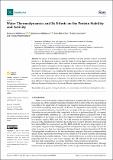Water Thermodynamics and Its Effects on the Protein Stability and Activity
Author(s)
Mallamace, Francesco; Mallamace, Domenico; Chen, Sow-Hsin; Lanzafame, Paola; Papanikolaou, Georgia
Downloadbiophysica-01-00030.pdf (792.9Kb)
Publisher with Creative Commons License
Publisher with Creative Commons License
Creative Commons Attribution
Terms of use
Metadata
Show full item recordAbstract
We discuss a phenomenon regarding water that was until recently a subject of scientific interest: i.e., the dynamical crossover, from the fragile to strong glass forming material, for both bulk and protein hydration water. Such crossover is characterized by a temperature <inline-formula><math xmlns="http://www.w3.org/1998/Math/MathML" display="inline"><semantics><msub><mi>T</mi><mi>L</mi></msub></semantics></math></inline-formula> in which significant dynamical changes like the decoupling (or the violation of the Stokes-Einstein relation) of homologous transport parameters, e.g., the density relaxation time <inline-formula><math xmlns="http://www.w3.org/1998/Math/MathML" display="inline"><semantics><mi>τ</mi></semantics></math></inline-formula> and the viscosity <inline-formula><math xmlns="http://www.w3.org/1998/Math/MathML" display="inline"><semantics><mi>η</mi></semantics></math></inline-formula>, occur in the system. On this respect we considered the dynamic properties of water-protein systems. More precisely, we focused our study on proteins and their hydration water, as far as bulk and confined water. In order to clarify the effects of the water dynamical crossover on the protein properties we considered and discussed in a comparative way previous and new experimental data, obtained from different techniques and molecular dynamic simulation (MD). We pointed out the reasons for different dynamical findings from the use of different experimental techniques.
Date issued
2021-10Department
Massachusetts Institute of Technology. Department of Nuclear Science and EngineeringJournal
Biophysica
Publisher
Multidisciplinary Digital Publishing Institute
Citation
Biophysica 1 (4): 413-428 (2021)
Version: Final published version